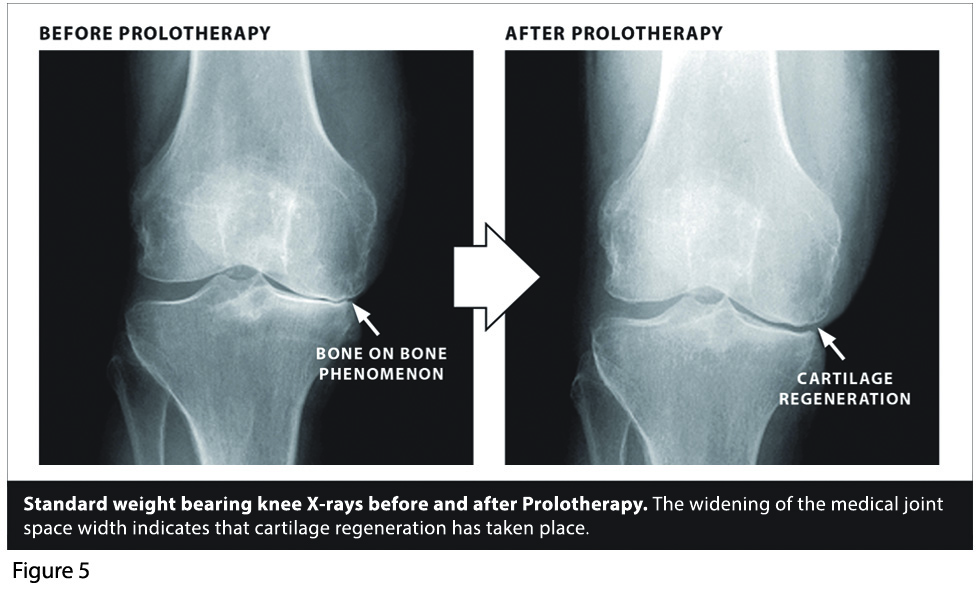Knee pain affects all types of people, hindering them from fully enjoying retirement, being able to work or play sports, or many other activities. It may keep the athlete from running a marathon, or simply make walking through the grocery store daunting. For our knees to move normally and remain healthy, all of the knee joint structures need to be healthy and stable. Regenerative Medicine treatments are growing in popularity to prevent the need for many knee replacement surgeries as well as the dangers of cortisone injections and pain prescriptions.
Knee instability – The missing diagnosis
Any change in the structures of the knee, including the tendons, ligaments, meniscus, and bone, sets the knee joint up for imbalance, joint instability, and further injury. Joint instability is the primary cause of most chronic knee pain conditions, yet most patients have never heard the term. (See figure 1.)

It is important for patients to understand that joint instability is a progressive condition. When one structure is injured, such as soft tissue or articular surfaces, other structures become affected. It is very common for secondary arthritis to develop in the knee. Osteoarthritis can occur within a few years with severe injuries, or take decades to occur when the injury is less severe. (See figure 2.)

Ligament and meniscal injuries
Ligaments play a crucial role in the stability of the knee, yet are particularly vulnerable when the loads placed on them exceed their allowed elasticity, which then results in overstretching, injury, and a destabilized joint. How often do we hear of athletes missing their entire season due to injuries such as an anterior cruciate ligament (ACL) tear? Oftentimes, injury to the meniscus occurs along with ACL injuries. Sometimes the co-injuries occur at the time of the trauma, in instances of excessive force, sufficient enough to tear the ACL and the meniscus, along with injury to other ligaments. The unstable knee joint transmits abnormal forces onto the cartilage and other knee structures, causing nagging symptoms of joint instability. (See figure 3.)

Realize that each structure of the knee is important, so if one structure is affected, the dynamics of the rest of the knee are altered.
Patellofemoral Pain Syndrome
Patellofemoral pain syndrome (PFPS) is another condition of joint instability which commonly affects knees of younger recreational runners. For maximum stability and performance, the patella (knee cap) should move smoothly through the patellofemoral groove of the femur. (See figure 4.)

With PFPS, instead of tracking in the groove of the femur, the patella oftentimes tracks laterally. After repeated episodes, the joint becomes unstable, especially if the joint remains out of alignment. This abnormal tracking can lead to increased wear between the bone surfaces, and eventually the articular cartilage. Regenerative injection therapy, along with vastus medialis strengthening, will relieve the pain and speed up the process of normalizing the patellar tracking in PFPS, allowing for a quick return to activities.
Knee Pain Treatment Options
More conservative, non-surgical therapies can be helpful for temporary pain relief, but not helpful at reversing joint instability or stopping the degenerative process. The most common are exercise, bracing, NSAIDs (non-steroidal anti-inflammatory drugs) and corticosteroid injections. Although steroid injections and NSAIDs have been shown to be effective in decreasing inflammation and pain short-term, the histological, biochemical, and biomechanical properties of ligament healing are inhibited. For this reason, their use is cautioned in those who have ligament and soft tissue injuries.
Non-surgical regenerative medicine techniques, on the other hand, have been shown to resolve ligament injuries, repair meniscal injuries, and rebuild cartilage in the knee. (See figure 5.)

These techniques are all under the umbrella of Prolotherapy (Regenerative Injection Treatment) and can include Platelet Rich Plasma and Stem Cell therapy, which have become more prevalent in sports and pain medicine. Prolotherapy treatments work by stimulating the normal inflammatory-reparative mechanisms of the body, laying down new collagen, and strengthening the soft tissue. This more comprehensive injection treatment is the exact opposite of cortisone that has short-term pain relief but long-term degenerative effects. Instead, Prolotherapy is ideal for preserving the long-term health of a joint and restoring stability, to naturally alleviate pain, versus just covering it up.
What about knee surgery?
Surgery, including arthroscopic surgery to attempt to repair the knee, may actually worsen joint instability, because ligaments and supporting structures are cut, stretched, scraped and removed. In the knee, meniscus and cartilage tissue are the most commonly removed structures. This changes the dynamics in the knee joint, causing destructive joint motions with continued use, and eventually resulting in the complete breakdown of the joint. Best to avoid this scenario and address knee pain in its earlier stages with regenerative options.
Regenerative Medicine Specialists
CaringMedical.com 239-303-4546 with locations in Fort Myers and Chicagoland







